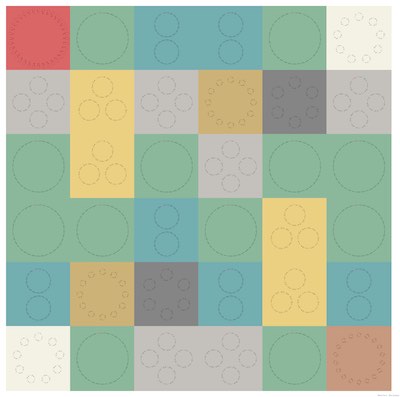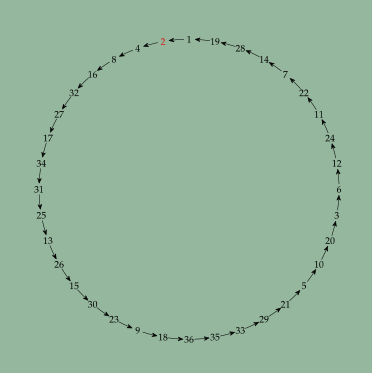36 Epicycles
Martin H. Weissman

Remainders are the cold leftovers of grade-school arithmetic. But they are the tastiest morsels for mathematicians. In school we are taught that quotients are answers and remainders are nearly thrown away. For example, 50 divided by 37 gives a quotient 1, with 13 “left over”. Mathematicians focus on these leftovers, and this image is full of them. Remainders can tell us a lot about prime numbers, and everyone who wants to keep their emails private should care about prime numbers.
 So what are these circles you see? Take the big circle in the green tile, near the top-left (reproduced here on the right). Starting at the top, the numbers are 1, 2, 4, 8, 16, 32. But the next number isn’t 64. Since 64÷37=1 R 27, the next number is the remainder: 27. Then you double again to 54. Since 54÷37=1 R 17, the next number is 17. And so on – just keep on doubling, and every time you see a number bigger than 37, you divide by 37 and take the remainder.
So what are these circles you see? Take the big circle in the green tile, near the top-left (reproduced here on the right). Starting at the top, the numbers are 1, 2, 4, 8, 16, 32. But the next number isn’t 64. Since 64÷37=1 R 27, the next number is the remainder: 27. Then you double again to 54. Since 54÷37=1 R 17, the next number is 17. And so on – just keep on doubling, and every time you see a number bigger than 37, you divide by 37 and take the remainder.
The big circle shows you that this process of doubling and remaindering takes you from 1 to 2 to 4, and eventually back to 1, after 36 steps.
On the other hand, if we triple instead of double, 1,3,9, and so on, we get back to 1 after 18 steps. That’s the bluish tile nextdoor. But why should you care? It turns out that these patterns of circles reflect the fact that 37 is prime.
You might not care about prime numbers, but without them, I could read all your private messages. To securely communicate over the internet, computers use large (300+ digit) prime numbers all the time. To find these numbers quickly, the computers look for patterns like the circles found here. And to encrypt your messages, the computers use modular exponentation — following paths along circles like these. The patterns were found by Fermat, Euler, and Gauss, centuries ago. They were thought to be useless back then, but they are fundamental to security today.
Experts will see the “primitive roots” (multiplicative generators) modulo 37, in the green tiles, and the Legendre symbol in the number of circles per tile. But non-experts might find other surprising structures hidden in the image.
The colors reflect the number of circles in each tile. Step back, and you might see a symmetry... or an "almost" symmetry... in the whole figure. I have chosen the nine colors so that the viewer can step back and focus on one color at a time, while associating similar colors (like shades of yellow/orange or green/blue) with each other. The colors, in fact, are digitally "borrowed" from multiple paintings of Josef Albers (Homage to the Square) for the way they interact.